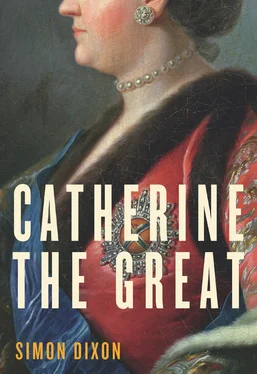* * *
Within two years of his accession to the Habsburg throne in 1765, Joseph II had reduced the number of religious services attended annually by his Court from seventy-eight to thirty-two. Ten more had gone by 1774. As a leading Viennese official noted, the emperor’s decision to abolish the Maundy Thursday ritual of washing the feet in 1767 created ‘an exceptional sensation’. 98In St Petersburg, such a move would have been inconceivable. Catherine may have worn her own religion lightly, but she had come to the throne as a defender of Orthodoxy. The number of religious rituals in the Russian Court calendar went up rather than down during her reign as her Court remained knee-deep in holy water.
The very first entry in the Court journals after the coup is from 1 August 1762, when the empress followed an elaborate clerical procession from the chapel at the Summer Palace to the blessing of the waters on the Moika canal at the beginning of the Dormition Fast. 99A similar ceremony was repeated three times in the 1760s, Catherine sheltering from the rain in 1764 in a specially constructed gallery. That was the year in which the Court clergy first staged an icon procession at mid-Pentecost, the moveable feast halfway between Easter and Trinity Sunday. On 30 August 1762, the empress made a point of processing on foot for more than two miles from the Kazan Church to worship at the relics of St Alexander Nevsky—a severe test of patience for one so sceptical. In later years, she either drove to the Anichkov Palace and processed from there or bypassed the annual icon procession altogether. Not until 1772 was she once again persuaded to complete the full route on foot. It was a similar story at Epiphany. Catherine followed the icons to the Jordan in both 1764 and 1765, while Zakhar Chernyshëv showed the watching Paul a plan of the layout of the 8900 soldiers on parade. After that, she was ill for several days and never again ventured out after being deterred by a severe frost in 1766, when the parade was cancelled and only a single company from each regiment braved the cold to present their standards to be dipped. 100For the remainder of her reign, Catherine was content to watch the blessing of the waters from the windows of the Winter Palace.
The palace’s great chapel had been consecrated on Easter Saturday, 1762, the day that Peter III moved in. Two weeks after her return from Moscow in 1763, Catherine had it re-consecrated in the name of the icon ‘not made by human hands’ (a version of this celebrated image, made seventy years earlier by F. F. Ukhtomsky and studded with gold and diamonds, was placed by the altar). Rastrelli had originally intended the chapel to extend to the full height of the palace, but eventually opted to place it on the first floor at the same level as the other staterooms so that, exceptionally for a sacred space, there were kitchens and laundries beneath, not to mention the bathhouse where Catherine later spent time with Potëmkin. The chapel remained a ‘very lofty and spacious room’, lined by ‘gilt Ionic pillars’ and decorated with icons which one visiting Protestant found ‘glaring and ill-executed’, but which are now reckoned among the finest examples of collaboration between Russian and Italian artists in the eighteenth century. Much of the plate was taken from the Moscow Armoury to represent a clear line of succession from Catherine’s Muscovite ‘ancestors’, and the chapel also housed treasured relics, including a cross incorporating a fragment of the Life-Giving Cross of Our Lord, an image of the Filermskaya Mother of God, said to be the work of St Luke, and part of the right hand of John the Baptist. 101In the depth of winter, Paul kept warm by listening to the service from an adjoining room while his mother regularly took her place behind the railing in front of the altar. Here she could listen to her choir, more than fifty strong by the late 1760s, perform works influenced by the Italian style by Western-educated composers such as Maxim Berezovsky. Daily services were accompanied by traditional chants and the occasional motet, but in the empress’s presence, on Sundays and lesser feast days, there was always an ornate mass, and the twelve great feasts in the Orthodox calendar were celebrated with a full-scale cantata. 102
Not that Catherine’s worship was confined to her palaces. On Thursday 17 October 1762, she and her entourage made the traditional post-coronation pilgrimage to the Trinity St Sergius monastery. Advised of her visit in August, the monks had lost no time in smartening the place up and preparing gorgeous new vestments. The suite where the empress was to stay was also rejuvenated. Proclaimed on her arrival as a ‘second Helen’ in piety and ‘the image of Judith of Israel’ in courage, Catherine was shown the library and took particular pleasure from debates between the pupils of the seminary, organised by its twenty-four-year-old rector, Archimandrite Platon. 103Father Platon made another favourable impression with a sermon on ‘the uses of piety’ when the empress returned to the monastery in the following May, on the first leg of her pilgrimage to Rostov. 104Following the pattern set by Elizabeth, she proceeded in crab-like fashion, covering up to seven miles on foot during the day, and then partially retracing her steps by carriage to spend the night at a favourite staging post. As far as the Trinity monastery, the route was dotted with imperial villages, each of which had its own small wooden ‘palace’. At Taininskoye, where the exquisite seventeenth-century church still stands in the shadow of a huge electric power station, a new log cabin had been built alongside the palace to house her suite. 105She made good progress, completing the journey in eleven days. However, as so often on Catherine’s travels, the elements were against her: driving wind and rain turned the roads to mud, ‘depriving us of the pleasure we might have taken from the journey in better times’. 106Pereyaslavl, where she arrived on 21 May, offered ‘foul weather and boredom in equal measure’. She stayed with a government official, whose house was ‘very large, good, and full of cockroaches’. The empress insisted, against the Church’s better wishes, that monasteries should serve some useful purpose by caring not only for the sick, but also for the insane. Less certain about the use of monasteries as gaols, she was appalled to discover a monastic prisoner who had been held captive at Pereyaslavl for fifteen years: ‘Find out about him!’ she ordered. 107Peasants had flocked to Rostov in the hope of glimpsing their sovereign and being cured by the saint’s relics. ‘Yesterday there was another miracle,’ reported the sceptical empress. ‘A woman was healed and Bishop [Dimitry] Sechënov wants to seal the casket, so that the relics cannot be stolen; however, in order that the common people shouldn’t think that the relics had been hidden from me, I requested that they be left out for some time longer.’ 108
Father Platon followed Catherine to St Petersburg at the beginning of August 1763. On Sunday 10 August, the empress travelled to the Trinity hermitage, where she had received representatives of the deposed Peter III on the day after her coup, to hear him preach at the consecration of the Baroque cathedral, begun seven years earlier to a design by Trezzini and completed under the supervision of the ubiquitous Rastrelli. 109Given rooms in Elizabeth’s temporary wooden palace, Platon was to deliver more than thirty sermons to Catherine and her Court over the next two years. In addition to his annual salary of 1000 roubles, he received a further 300 for subsistence, and was supplied not only with firewood and candles, but also with beer, more than a litre of vodka each week and a bottle of Rhine wine every day. Although Panin worried that this ‘clear-headed’ monk might be corrupted by his new surroundings, he remained alert to the dangers of ambition and extravagance. Several of his Lenten sermons touched on the temptations faced by hedonistic courtiers, and on 10 October 1764 he ‘spoke with considerable vehemence against those who ruin themselves by squandering their wealth on frivolous and unnecessary things and, consequently, are unable to be of any help to the poor’. ‘Father Platon was in a bad mood today,’ Catherine remarked afterwards, ‘but he spoke extremely well.’ 110Always impressed by the young monk’s eloquence, she had been moved to tears by his sermon on the tsarevich’s tenth birthday on 20 September. Many in the congregation also wept at the end, when ‘the preacher spoke of her Majesty’s patience in bearing her labours for the use and safety of the fatherland, on the success of his Highness in the sciences which he was taught, and the resultant hope for Russia’. 111Catherine had herself attended Paul’s first lesson with Platon on 29 August 1763, the Feast of the Beheading of St John the Baptist. Two years later, she stood at her son’s side as he faced a carefully rehearsed oral examination on matters of basic dogma in the presence of a large number of courtiers. ‘Her Majesty deigned to listen with the greatest attention,’ Poroshin recorded. ‘The examination lasted for three quarters of an hour. After it was completed, Reverend Father Platon addressed her Majesty in a brief speech. The Sovereign lady deigned to thank him for teaching the Grand Duke, about whom she said: “I thought he would be shy, but not all; he answered very well.”’ 112
Читать дальше












